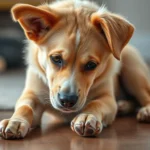
Introduction
Aggression and reactivity in dogs are issues that many pet owners face, and understanding these behaviors is crucial for the safety and well-being of both the dog and those around them. Aggression refers to a dog’s intent to cause harm or injury, while reactivity describes a dog’s overreaction to specific stimuli, which may not necessarily be aggressive but can lead to aggressive displays.
There are several common misconceptions surrounding these behaviors. Many people assume that an aggressive dog is simply “bad” or “mean,” overlooking the underlying fears or triggers that may cause such behaviors. Addressing these issues is essential, not just for safety but also for the emotional well-being of the dog and the family. An aggressive or reactive dog can create stress and anxiety at home, impacting the entire household dynamic.
To navigate this challenge, it’s vital to have actionable strategies that can be implemented. This article will delve into the signs of aggression, types of aggressive behavior, and practical approaches to help manage and modify these behaviors.
Understanding Dog Behavior
Canine Body Language
Understanding canine body language is the first step in managing aggression or reactivity. Dogs communicate through various signals that indicate their comfort or discomfort in a situation.
Signs of Aggression vs. Reactivity:
– Aggression: This may include a stiff body posture, raised hackles, bared teeth, and a growl.
– Reactivity: This can manifest as barking, lunging, or excessive whining in response to a trigger.
Recognizing these signs helps in understanding the dog’s emotional state and can prevent escalation into aggression.
Understanding Triggers
Triggers can vary widely from one dog to another. Common stimuli that provoke aggression or reactivity include:
– Strangers approaching
– Other dogs, especially those invading personal space
– Loud noises, such as thunder or fireworks
Being aware of these triggers allows for better management and preparation when these situations arise.
Types of Aggression
Understanding the different types of aggression can aid in addressing the specific needs of your dog.
Fear-Based Aggression: This occurs when a dog feels threatened. For example, a dog may growl or snap when approached by a stranger if it feels cornered or scared.
Territorial Aggression: Dogs may become aggressive when they perceive an intrusion into their territory, such as a stranger walking past the home.
Protective Aggression: This behavior is different from fear-based aggression, as it involves the dog defending its owner or another dog from perceived threats.
Frustration-Induced Aggression: This can arise when a dog is prevented from reaching something it desires, such as another dog to play with or a toy it wants.
Assessing Your Dog’s Behavior
Observing and Documenting Behavior
Keeping a behavior journal is a helpful tool in understanding and managing your dog’s aggression or reactivity. In this journal, note:
– Frequency of aggressive or reactive incidents
– Duration of each episode
– Specific triggers present during each occurrence
This documentation can reveal patterns over time, helping you identify situations that consistently lead to aggressive or reactive behavior.
Professional Evaluation
Recognizing the limits of self-assessment is crucial. If your dog exhibits concerning behaviors, knowing when to seek professional help is essential.
Types of Professionals to Consult:
– Veterinarians can rule out medical issues that may contribute to aggressive behavior.
– Certified trainers or animal behaviorists can provide tailored strategies and training programs to address specific issues.
Strategies for Managing Aggression and Reactivity
Immediate Safety Measures
Safety should always come first when dealing with an aggressive or reactive dog.
Using Leashes and Muzzles: Properly fitting leashes and muzzles can prevent unwanted bites and provide a sense of security for the owner. Introducing a muzzle should be done gradually, ensuring that the dog associates it with positive experiences.
Creating Safe Spaces at Home: Designating an area in your home where your dog feels comfortable can minimize stress. This space should be free from triggers and provide a safe retreat for your dog.
Training Techniques
Training is a vital component of helping an aggressive or reactive dog.
Positive Reinforcement: Using treats and praise to reward desired behaviors encourages your dog to repeat those actions. This method fosters a positive learning environment.
Desensitization and Counter-Conditioning: Gradually exposing your dog to its triggers at a distance where it feels safe can help lessen its reactivity. Pair this exposure with treats to create a positive association.
Basic Commands and Obedience Training: Teaching commands like “sit,” “stay,” and “leave it” can provide owners with tools to manage their dog’s behavior in challenging situations.
Socialization Practices
Socialization is key in developing a well-adjusted dog.
Safe Introduction to Other Dogs and People: Controlled introductions can help your dog learn to interact positively with others. This can be done in a calm environment, ensuring positive reinforcement is used.
Dog Parks and Group Classes: While these can be beneficial, they also come with risks. Ensure your dog is ready for such environments, as poorly managed introductions can exacerbate aggression.
Long-Term Solutions
Creating a Consistent Routine
Establishing a consistent daily routine is crucial for the mental well-being of your dog.
Establishing Daily Schedules: Regular feeding, walking, and playtime can help your dog feel secure and reduce anxiety.
Incorporating Regular Exercise: Physical activity is a natural stress reliever and can help manage excess energy that may lead to reactive behaviors.
Monitoring Progress
Tracking your dog’s behavior over time can provide insight into the effectiveness of training methods.
Adjusting Training Techniques: If progress stalls, it may be necessary to change tactics. Consult with a professional for fresh strategies.
Celebrating Small Wins: Acknowledge and celebrate improvements, no matter how small. This reinforces positive behavior and motivates further progress.
When to Consider Professional Help
Identifying Severe Cases
Recognizing when the situation may require professional intervention is essential.
Signs that Indicate a More Serious Issue: Escalating aggression, such as repeated biting or the inability to control behavior in familiar environments, warrants professional guidance.
Types of Professional Help Available: Specialized trainers often focus on specific behavioral issues, while behaviorists can offer in-depth assessments and treatment plans.
Understanding Medication Options
In some cases, medication may be a necessary component of treatment.
When Medication Might Be Necessary: Severe anxiety or aggression can sometimes be alleviated with medication, which should always be discussed with a veterinarian.
Consulting with a Veterinarian: A veterinarian can provide guidance on whether medication is suitable for your dog, considering their unique circumstances.
Resources for Dog Owners
Recommended Books and Websites
There are numerous educational materials available for dog owners seeking to understand and manage aggression and reactivity.
Educational Material for Further Reading: Books by renowned authors in dog behavior can offer additional insights and training techniques.
Support Groups and Classes
Connecting with others facing similar challenges can provide emotional support and practical solutions.
Finding Local Training Classes: Look for certified trainers in your area who specialize in aggression and reactivity. Group classes can offer both socialization opportunities and professional guidance.
Joining Support Networks: Online forums and local support groups can provide valuable resources and community connections for dog owners.
Conclusion
Helping an aggressive or reactive dog requires understanding, patience, and commitment. By recognizing the signs of aggression, identifying triggers, and implementing effective training strategies, dog owners can work towards a more harmonious relationship with their pets. Remember to celebrate progress, no matter how small, and remain dedicated to the process. With persistence and the right resources, you can help your dog become a more confident and relaxed companion.
FAQ Section
Common Questions About Aggressive and Reactive Dogs
Here are some frequently asked questions that may clarify doubts regarding aggression and reactivity in dogs.
Can all aggressive dogs be trained?
Yes, most aggressive dogs can be trained with the right methods and professional guidance.
Is it safe to use a muzzle?
Yes, muzzles can be safe and helpful when introduced properly, allowing for controlled interactions.
Myths vs. Facts
Myth: Aggressive dogs cannot be rehabilitated.
Fact: With proper training and support, many aggressive dogs can improve significantly.
Understanding these aspects is essential for any dog owner dealing with aggression or reactivity. By implementing the strategies discussed, you can create a safer and more enjoyable environment for your dog and those around you.



